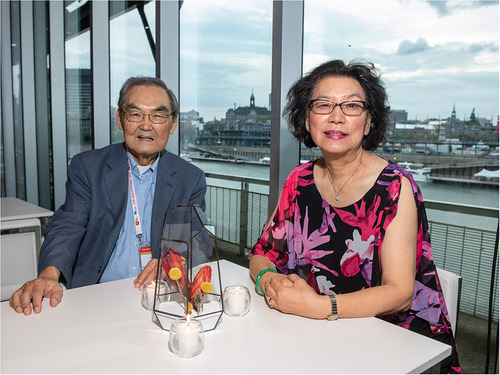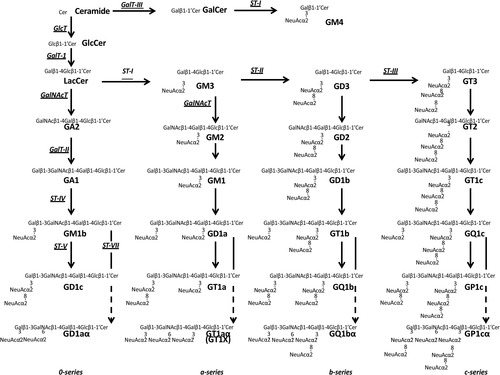Dr. Robert K. Yu, affectionately known to most of his friends and colleagues as “Bob,” passed away peacefully on May 18, 2022, at the age of 84. Bob served as President of the American Society of Neurochemistry (ASN) from 2001 to 2003 where he instituted a number of foundational changes that improved membership and strengthened financial solvency (). Bob received his BS in Chemistry from Tunghai University, Taiwan, in 1960. He received his PhD in Biochemistry from the University of Illinois Urbana/Champaign in 1967 under the mentorship of Dr. Herbert E. Carter, a member of the National Academy of Sciences. Bob followed in the footsteps of his beloved and accomplished mother, Dr. June Yu, who graduated from the University of Illinois Urbana/Champaign with a PhD in Chemistry and was a pioneer as the first Chinese woman to receive a PhD in Chemistry in the US. Bob completed postdoctoral training in the Department of Neurology at the Albert Einstein College of Medicine/Yeshiva University from 1967 to 1972 under the mentorship of Dr. Robert W. Ledeen, a long-standing member of ASN.
Bob began his long and distinguished scientific career as an Assistant Professor in the Departments of Neurology and Molecular Biology and Biochemistry at Yale University in 1973. Bob was rapidly promoted to tenured Professor where he worked until 1988. Bob received a Med. Sci. D. honorary degree from the University of Tokyo in 1980 and an M.A.H. honorary degree from Yale University in 1985. Bob was recruited as Chair and Professor of the Department of Biochemistry and Molecular Biophysics at the Medical College of Virginia/Virginia Commonwealth University. In 2000, Bob was recruited as Director and Professor of the Institute of Molecular Medicine and Genetics at the Medical College of Georgia and served in that capacity until 2009. He also served as President of the Society of Chinese Bioscientists in America from 2008 to 2010. He held the Chair of Georgia Research Alliance Eminent Scholar in Molecular and Cellular Neurobiology, and was the Founding Director of the Institute of Neuroscience at Georgia Health Sciences University, now Augusta University, until his death.
Bob’s major research interests were in neurochemistry and developmental neurobiology, particularly as related to glcoconjugates in health and diseases. He published over 400 peer-reviewed scientific papers and served as a senior editor in several high-profile scientific journals including Journal of Lipid Research, Journal of Biological Chemistry, and ASN Neuro. Bob was widely regarded as a leader in the field of glycosphingolipid research. He widely supported the expansion of the Japan Oil Chemists’ Society. For over 40 years, he and his research teams characterized numerous glycosphingolipid structures and elucidated their biophysical properties, biosynthetic pathways, and biological functions. Bob and Dr. Robert Ledeen were the first to demonstrate that the naturally occurring sialidase-susceptible sialic acid linkage contained the α-D configuration. This discovery was a major milestone in the field. His laboratory has been credited for the isolation and characterization of nearly one-third of all brain gangliosides and many other glycosphingolipids, including the sulfoglucuronyl glycolipids, which are widely known as markers of the human natural killer cell (the HNK-1 antigens) and neural progenitor cells.
To elucidate the structures of glycolipids, Bob pioneered the development of various physical techniques such as two-dimensional-nuclear magnetic resonance (with James Prestegard), monolayer and differential microcalorimetry (with Julian Sturtevant and Bruno Maggio), mass spectrometry (with Kenneth Rinehart and Toshio Ariga), and high-performance thin-layer chromatography (with Susumu Ando). These developments paved the way for research on glycosphingolipid functions and properties of glycolipids and membrane glycolipid-rich microdomains.
In addition to elucidating numerous glycosphingolipid structures, including GM4, GT1a, and GQ1c, Bob also discovered the “c” metabolic pathway for ganglioside biosynthesis (). This discovery led to the completion of the “a- and b-pathways” of ganglioside biosynthesis, which is now cited in many textbooks. He also provided insights into the regulatory mechanisms of biosynthesis of the various glycosphingolipids during nervous system development, particularly the a-to-b pathway switch in neural stem cell differentiation. He is among the first to have cloned the cDNAs of many glycosyltransferases and sialidases, established their gene organization, and elucidated their transcriptional and posttranslational control mechanisms during nervous system development. He was instrumental in developing antisense technologies as an aid to uncover the biological function of glycolipid expression in cells. He is also among the first to systematically elucidate the expression and functional roles of glycoconjugates in neural stem cells and continues to make major contributions in this developing area.
In addition to the above accomplishments, Bob elucidated the immunological properties of glycosphingolipids and pioneered immunopathogenic mechanisms of multiple sclerosis, peripheral neuropathies, and other related neurodegenerative disorders. He is responsible for the characterization of many of the glycolipid antigens and antibodies involved in these neurological disorders and established the first experimental models of peripheral neuropathies (Guillain–Barré syndrome [GBS]). Most significantly, he provided evidence linking these diseases to infectious agents through the mechanism of molecular mimicry. His work was essential in helping develop novel treatment strategies for GBS and is now at the forefront of clinical and translational medicine in this area.
Bob had a warm and friendly demeanor and a good sense of humor. He was always interested in discussing new research developments with both established scientists and students alike. He had a great commitment to helping others in their carrier development or personal lives and was an outstanding mentor for many scientists who continued to share his passion for glycolipid research. He will be greatly missed by his family, friends, and all those who knew him. Bob is pictured with his wife Helen at one of the many ASN meetings that they attended together ().
Author’s Note
Toshio Ariga, Department of Neuroscience and Regenerative Medicine, Medical College of Georgia, Augusta University, Augusta, GA, USA.
ORCID iD
Erhard Bieberich https://orcid.org/0000-0001-8490-7395


